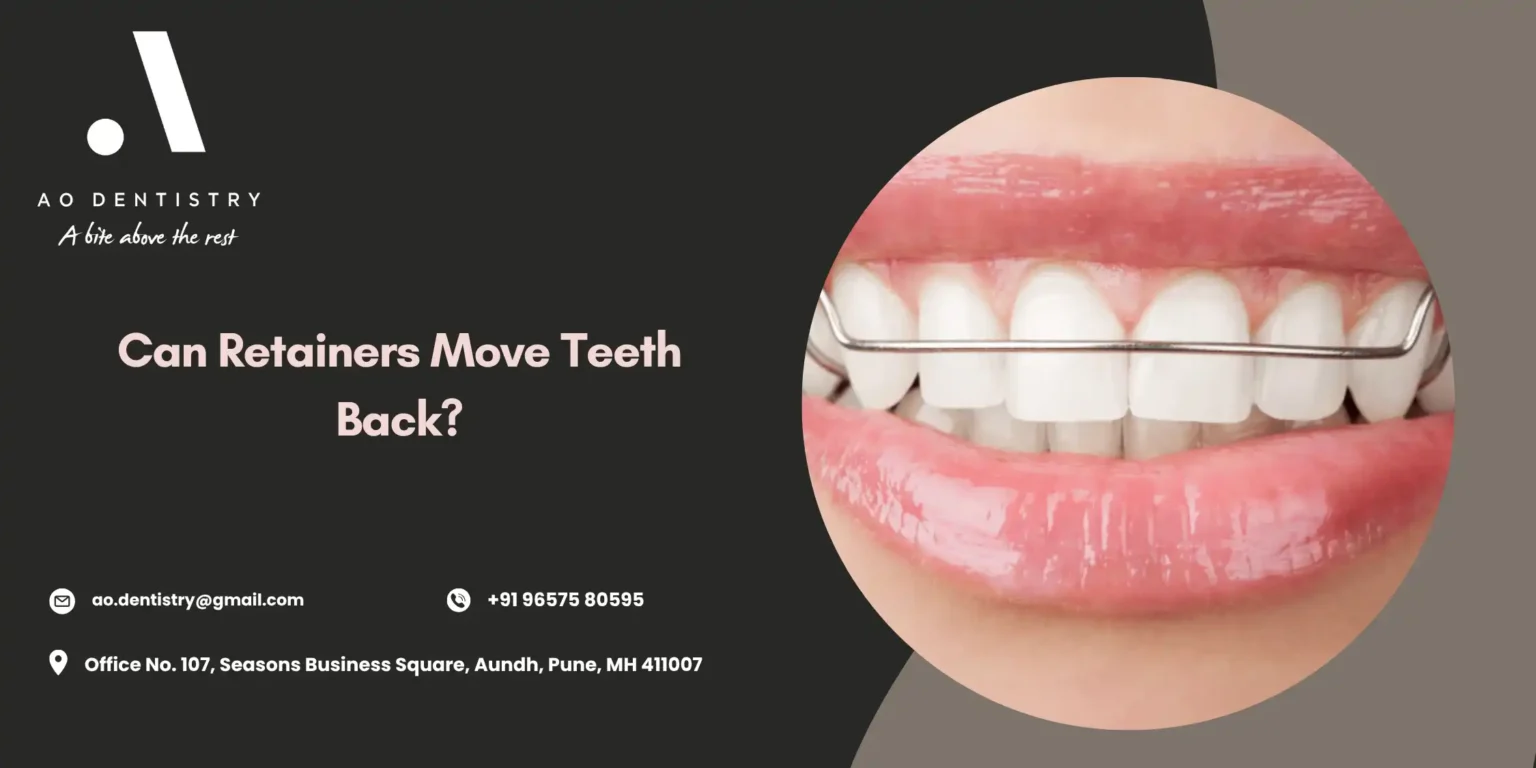Have you been searching for questions like “Can retainers move teeth back?”, “Do retainers shift teeth back?”, or “Will my teeth move back with a retainer?” If yes, you’re not alone. Many people wonder about the effectiveness of retainers in correcting minor tooth movements after braces. In this article, you’ll find clear answers to all your questions — from what retainers are and why they’re used, to the best conditions for them to work, and what to expect during treatment.
Want to know what the difference is between aligners and braces?
What Are Retainers and Why Are They Used?
Before exploring can retainers move teeth back or can retainers shift teeth back or will teeth move back with retainer let’s understand what are retainers and why are they used
After braces are taken off, the real work starts, keeping teeth in their new positions. This is when people ask can retainer push teeth back to where they belong. Retainers take on this crucial responsibility, acting as guardians against the natural tendency of teeth to wander.
Three main retainer varieties exist in modern orthodontics. Each type shows how can retainers shift teeth back differently.
Fixed retainers involve a thin wire bonded directly to the tongue-side surface of front teeth. People often wonder can retainer push teeth back with this permanent design. This permanent solution requires zero patient cooperation since it works continuously.
Hawley retainers: Many wonder do retainers move teeth back or can hawley retainers push teeth back with this traditional design. Hawley retainers bring old-school reliability to retention. These devices combine pink or clear acrylic that sits against the roof of the mouth with bendable wires that hold teeth in place. While that front wire might be visible when smiling, these devices can survive years of use and allow orthodontists to make minor adjustments when needed.
Clear retainers slide over teeth like a transparent shell, offering maximum discretion. Patients frequently ask do retainers move teeth back with clear aligners too or can a plastic retainer move teeth back. Made from thermoplastic material, they’re virtually invisible but need replacing every couple of years as the plastic weakens or discolors.
The need for retention stems from biology. Teeth live in a dynamic environment where tiny fibers act like elastic bands with excellent memory. These periodontal ligaments spent years holding teeth in their original positions and don’t forget easily have spent years holding teeth in their original positions and don’t forget easily. Remove the retaining force, and teeth begin their journey back to their original position, sometimes within days of completing orthodontic treatment. This natural tendency explains why can retainer push teeth back becomes so important.
Click here to learn more about Types of Crowns for Teeth
Can Retainers Move Teeth Back Into Place?
Can retainers move teeth back or can retainers shift teeth back? Or can a retainer move teeth back into place? Or will teeth move back with retainer? Success depends on multiple factors working in harmony.
Favorable conditions for retainer correction:
- Minor tooth movement
- Recent changes
- No major bite adjustments
- Healthy and well-maintained structures of gums and bones
Understanding these factors helps answer do retainers move teeth back successfully
Situations requiring professional treatment:
- Major gaps or spacing changes
- Severe rotation of single teeth
- Bite doest not come together
- More than one teeth have shifted positions
- Changes that occurred years ago
In these cases, do retainers move teeth back or can teeth go back after braces becomes unlikely without professional help.
The distinction between “minor” and “major” movement matters tremendously. Retainers can guide teeth that are slightly off course, but they can’t drag teeth across significant distances. Once the bone fully remodels around the new tooth positions, usually after several months, the window for simple correction closes.
How Do Retainers Work to Realign Teeth?
Before asking can retainers move teeth back or can retainers shift teeth back or will teeth move back with retainer, it is important to understand the science behind tooth movement.
Moving teeth through bone happens through predictable biological processes. Understanding this mechanism explains why retainers sometimes succeed and sometimes fail at correction.
Applied pressure triggers a cellular chain reaction. Where force presses against bone, cells known as osteoclasts arrive to dissolve the bone tissue, creating space. On the opposite side, where tension exists, osteoblasts lay down new bone to fill the void. This process allows teeth to slowly migrate through what seems like solid jaw bone.
Retainers build gentle forces enough to maintain position or correct minor shifts, but insufficient for major movements.
Clear retainers distribute pressure uniformly across all teeth, making them ideal for maintaining overall arch form.
Hawley retainers permit selective adjustments orthodontists can activate specific areas to target individual teeth.
Fixed retainers provide constant resistance against forward-backward movement, particularly effective for lower incisors prone to crowding.
The biological timeline can’t be rushed. Bone remodeling follows its own schedule,
typically allowing about one millimeter of movement monthly under ideal conditions.
Click here to read How to use mouthwash?
How to stop tooth decay from spreading? Read this article
Best Conditions for Retainers to Work
Creating ideal conditions for correction improves success rates. Will teeth move back with retainer or wear alone or can retainers shift teeth back? Or will teeth move back with retainer? Here’s what needs to align:
The timing factor:
Fresh movement responds best. Teeth that shifted recently are easy to redirect than those that moved earlier. Every passing day allows supporting structures to adapt to new positions and make corrections.
Proper fit requirements:
The retainer needs to fit properly without causing trauma:
- Firm pressure indicates potential success
- Mild discomfort suggests active correction
- Sharp pain signals excessive force
- Incomplete seating means stop immediately
Necessary commitment levels:
Wearing a retainer “sometimes” won’t accomplish your teeth smile goal. Successful correction demands some serious commitment:
- 22+ hours daily during active correction
- Remove only for eating and hygiene
- Continue for weeks after teeth appear straight
- Slowly transition to the maintenance schedule
Supporting health factors:
Healthy tissues respond predictably. Gum disease, active decay, or bone loss compromises treatment predictability. Smoking slows the healing. Certain medications can also affect bone metabolism.
Understanding when can retainers move teeth back or can retainers shift teeth back successfully requires knowing the right conditions.
Here’s what you can eat after tooth extraction.
How Long Does It Take for Retainers to Move Teeth?
Patience becomes essential when attempting correction with retainers. Biological processes follow their own timeline regardless of human desires for quick fixes.
Tiny shifts (less than 1mm):
First improvements might appear within 10-14 days. Complete correction typically needs 4-6 weeks. Stabilization requires an additional 2-3 months of faithful retention.
Small corrections (1-2mm):
Initial changes appear around week three or four. Full alignment requires 8-12 weeks of dedicated wear. Maintaining results demands extended retention periods.
Moderate shifts (2-3mm):
Visible improvement takes 6-8 weeks minimum. Complete correction stretches to 4-6 months. Success becomes less predictable at this level.
Individual variations create wide ranges in treatment duration:
- Bone density affects remodeling speed
- Root length influences resistance to movement
- Direction matters tipping happens faster than bodily translation
- The upper arch often responds quicker than the lower
- Rotational corrections take the longest
Remember, these estimates assume everything goes perfectly. Poor compliance, health issues, or compromised retainer fit can double or triple these timeframes.
Here are a few home remedies for swollen gums
Steps to Take If Teeth Have Shifted
Before panicking about whether can retainers move teeth back in your case, follow these steps. Discovering tooth movement requires a strategic response, not desperation.
Initial evaluation:
- Locate and inspect your retainer for damage
- Gently attempt insertion without forcing
- Note areas of excessive pressure
- Assess overall fit quality
If the retainer fits acceptably:
- Begin gradually to avoid overwhelming discomfort:
- Start with 2-3 hour intervals
- Increase by 2 hours daily
- Progress to overnight wear within a week
- Advance to full-time use as tolerated
Mild soreness mimics the feeling after braces adjustments, uncomfortable but manageable. This indicates active tooth movement.
Warning signs demanding professional attention:
- Severe, escalating pain
- Gum tissue turning white or bleeding
- Teeth feeling loose or wobbly
- Inability to bite normally
- Visible gum recession
- Retainer cracking during insertion
Professional consultation should evaluate:
- Current versus original tooth positions
- Root angulation and bone levels
- Periodontal health status
- Realistic correction possibilities
- Need for new retainers or active treatment
Many wonder can a plastic retainer can move teeth back without supervision? While possible for minor corrections, professional monitoring prevents complications and ensures progress.
Want to know the causes of yellow teeth
How to stop tooth decay from spreading? Read this article
Retainers After Braces: What to Expect
The retention phase represents a lifelong commitment. Modern orthodontics recognizes that teeth never truly settle into permanent positions.
Initial retention period: first 12 months
This critical period demands full attentiveness. Teeth remain highly unstable, surrounded by stretched fibers eager to pull them back. Full-time wear becomes non-negotiable except during:
- Eating meals
- Brushing and flossing
Adjustment challenges go away quickly. Speech normalizes within days. Excess saliva production resolves within a week.
Transition phase: years 2-3
Many cases allow reduction to nighttime-only wear. Complex treatments might require extended daytime use.
Lifetime maintenance:
Modern orthodontics advocates lifetime retention. Not around the clock forever, but wear nightly indefinitely. Consider it insurance for protecting your orthodontic investment.
Maintenance protocols:
- Rinse immediately after removal
- Clean with cool water and a soft brush
- Avoid toothpaste on clear retainers
- Weekly deep cleaning with denture cleanser
- Store in a protective case when not worn
- Keep away from heat sources
- Never wrap in napkins
- Replace clear types every 2-3 years
- Hawley retainers last 5-10 years, typically
How to Stop Grinding Teeth in Sleep Naturally, Read here
FAQs
Q1. Can a retainer move a tooth back?
Ans. Individual teeth can return to their proper position when movement stays minimal under 3mm. The retainer must fit properly without requiring dangerous force levels.
Q2. Is it bad to start wearing your retainer again?
Ans. Resuming retainer wear generally helps unless the retainers no longer fits properly.
Q3. How long should I wear my retainer to move my teeth back?
Ans. Minor corrections require full-time wear for 22+ hours for at least 6-8 weeks, followed by months of retention. Larger movements need longer treatment if they’re possible at all.
Q4. Can teeth move with a permanent retainer?
Ans. Fixed retainers prevent most movement in attached teeth, but problems arise if wires break or debond. Teeth not included, usually molars remain free to shift. Regular checks ensure continued effectiveness.
Q5. Will my teeth move back if I stop wearing my retainer?
Ans. Yes, guaranteed. The question isn’t if they will move or not, but when and how much. Some people notice changes within weeks, others might go months before without shifts.
Q6. Is it okay to wear retainers forever?
Ans. Absolutely. It is okay to wear retainers forever. No harmful effects come from retainer use.
To understand can retainers move teeth back or can retainers shift teeth back or do retainers move teeth back or can retainer push teeth back requires recognizing both their potential and limitations.
Now stop searching can retainers shift teeth back, consult with AO Dentistry for expert evaluation. Book your appointment today at AO Dentistry. Contact now via WhatsApp at +91-9657580595


